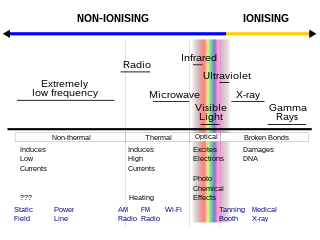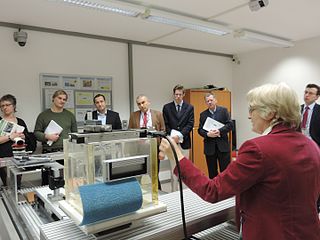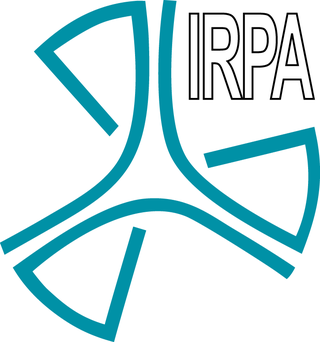
Electromagnetic radiation can be classified into two types: ionizing radiation and non-ionizing radiation, based on the capability of a single photon with more than 10 eV energy to ionize atoms or break chemical bonds. Extreme ultraviolet and higher frequencies, such as X-rays or gamma rays are ionizing, and these pose their own special hazards: see radiation poisoning. The field strength of electromagnetic radiation is measured in volts per meter (V/m).

The sievert is a unit in the International System of Units (SI) intended to represent the stochastic health risk of ionizing radiation, which is defined as the probability of causing radiation-induced cancer and genetic damage. The sievert is important in dosimetry and radiation protection. It is named after Rolf Maximilian Sievert, a Swedish medical physicist renowned for work on radiation dose measurement and research into the biological effects of radiation.
Ionizing radiation (US) (or ionising radiation [UK]), including nuclear radiation, consists of subatomic particles or electromagnetic waves that have sufficient energy to ionize atoms or molecules by detaching electrons from them. Some particles can travel up to 99% of the speed of light, and the electromagnetic waves are on the high-energy portion of the electromagnetic spectrum.
Medical physics deals with the application of the concepts and methods of physics to the prevention, diagnosis and treatment of human diseases with a specific goal of improving human health and well-being. Since 2008, medical physics has been included as a health profession according to International Standard Classification of Occupation of the International Labour Organization.

Radiation dosimetry in the fields of health physics and radiation protection is the measurement, calculation and assessment of the ionizing radiation dose absorbed by an object, usually the human body. This applies both internally, due to ingested or inhaled radioactive substances, or externally due to irradiation by sources of radiation.
Radiation protection, also known as radiological protection, is defined by the International Atomic Energy Agency (IAEA) as "The protection of people from harmful effects of exposure to ionizing radiation, and the means for achieving this". Exposure can be from a source of radiation external to the human body or due to internal irradiation caused by the ingestion of radioactive contamination.

Health physics, also referred to as the science of radiation protection, is the profession devoted to protecting people and their environment from potential radiation hazards, while making it possible to enjoy the beneficial uses of radiation. Health physicists normally require a four-year bachelor’s degree and qualifying experience that demonstrates a professional knowledge of the theory and application of radiation protection principles and closely related sciences. Health physicists principally work at facilities where radionuclides or other sources of ionizing radiation are used or produced; these include research, industry, education, medical facilities, nuclear power, military, environmental protection, enforcement of government regulations, and decontamination and decommissioning—the combination of education and experience for health physicists depends on the specific field in which the health physicist is engaged.
The roentgen equivalent man (rem) is a CGS unit of equivalent dose, effective dose, and committed dose, which are dose measures used to estimate potential health effects of low levels of ionizing radiation on the human body.
Specific absorption rate (SAR) is a measure of the rate at which energy is absorbed per unit mass by a human body when exposed to a radio frequency (RF) electromagnetic field. It is defined as the power absorbed per mass of tissue and has units of watts per kilogram (W/kg).

The linear no-threshold model (LNT) is a dose-response model used in radiation protection to estimate stochastic health effects such as radiation-induced cancer, genetic mutations and teratogenic effects on the human body due to exposure to ionizing radiation. The model statistically extrapolates effects of radiation from very high doses into very low doses, where no biological effects may be observed. The LNT model lies at a foundation of a postulate that all exposure to ionizing radiation is harmful, regardless of how low the dose is, and that the effect is cumulative over lifetime.

The antennas contained in mobile phones, including smartphones, emit radiofrequency (RF) radiation ; the parts of the head or body nearest to the antenna can absorb this energy and convert it to heat. Since at least the 1990s, scientists have researched whether the now-ubiquitous radiation associated with mobile phone antennas or cell phone towers is affecting human health. Mobile phone networks use various bands of RF radiation, some of which overlap with the microwave range. Other digital wireless systems, such as data communication networks, produce similar radiation.
The International Commission on Radiological Protection (ICRP) is an independent, international, non-governmental organization, with the mission to protect people, animals, and the environment from the harmful effects of ionising radiation. Its recommendations form the basis of radiological protection policy, regulations, guidelines and practice worldwide.

The United Nations Scientific Committee on the Effects of Atomic Radiation (UNSCEAR) was set up by resolution of the United Nations General Assembly in 1955. Twenty-one states are designated to provide scientists to serve as members of the committee which holds formal meetings (sessions) annually and submits a report to the General Assembly. The organisation has no power to set radiation standards nor to make recommendations in regard to nuclear testing. It was established solely to "define precisely the present exposure of the population of the world to ionizing radiation". A small secretariat, located in Vienna and functionally linked to the United Nations Environment Programme (UNEP), organizes the annual sessions and manages the preparation of documents for the committee's scrutiny.
Radiobiology is a field of clinical and basic medical sciences that involves the study of the effects of ionizing radiation on living things, in particular health effects of radiation. Ionizing radiation is generally harmful and potentially lethal to living things but can have health benefits in radiation therapy for the treatment of cancer and thyrotoxicosis. Its most common impact is the induction of cancer with a latent period of years or decades after exposure. High doses can cause visually dramatic radiation burns, and/or rapid fatality through acute radiation syndrome. Controlled doses are used for medical imaging and radiotherapy.
The Australian Radiation Protection and Nuclear Safety Agency (ARPANSA) is a regulatory agency under the Commonwealth of Australia that aims to protect Australian citizens from both ionising and non-ionising radiation. ARPANSA works under the guidance of the Australian Radiation Protection and Nuclear Safety Act of 1998 as the national regulatory body of radiation in Australia, with independent departments within each state and territory that regulate radiation within each of their jurisdictions.

Branko Bošnjaković is a Dutch-Croatian physicist and professional working in the field of environmental protection and sustainability.
Electromagnetic field monitors measure the exposure to electromagnetic radiation in certain ranges of the electromagnetic spectrum. This article concentrates on monitors used in the telecommunication industry, which measure exposure to radio spectrum radiation. Other monitors, like extremely low frequency monitors which measure exposure to radiation from electric power lines, also exist. The major difference between a "Monitor" and a "Dosimeter" is that a Dosimeter can measure the absorbed dose of ionizing radiation, which does not exist for RF Monitors. Monitors are also separated by "RF Monitors" that simply measure fields and "RF Personal Monitors" that are designed to function while mounted on the human body.
Exposure to ionizing radiation is known to increase the future incidence of cancer, particularly leukemia. The mechanism by which this occurs is well understood, but quantitative models predicting the level of risk remain controversial. The most widely accepted model posits that the incidence of cancers due to ionizing radiation increases linearly with effective radiation dose at a rate of 5.5% per sievert; if correct, natural background radiation is the most hazardous source of radiation to general public health, followed by medical imaging as a close second. Additionally, the vast majority of non-invasive cancers are non-melanoma skin cancers caused by ultraviolet radiation. Non-ionizing radio frequency radiation from mobile phones, electric power transmission, and other similar sources have been investigated as a possible carcinogen by the WHO's International Agency for Research on Cancer, but to date, no evidence of this has been observed.

The International Radiation Protection Association (IRPA) is an independent non-profit association of national and regional radiation protection societies, and its mission is to advance radiation protection throughout the world. It is the international professional association for radiation protection.
Michael Harry Repacholi is an Australian biophysicist and radiation protection expert. He is one of the pioneer scientists and foremost authorities in Radiobiology in the world, including radiation protection standards for ionizing radiation and non-ionizing radiation across the electromagnetic spectrum. He was one of the founders and past presidents of the International Commission on Non-Ionizing Radiation Protection (ICNIRP) and founder and director of several projects in the World Health Organization, including the International Electromagnetic Fields (EMF) Project. Repacholi was also active in the study of the health consequences of the Chernobyl accident in the nuclear reactor, in Ukraine.









